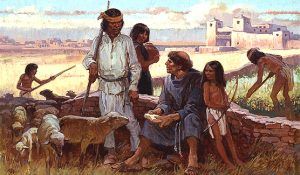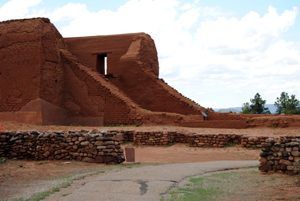
Pecos Indians
Formerly the largest and most populous of the Pueblo Indians of New Mexico in historic times, these people built the Pecos Pueblo situated on the upper branch of Pecos River, about 30 miles southeast of Santa Fe.
The people spoke the same language of the Tanoan Family, with dialectic variations, like that of Jemez; also situated on an upper branch of Pecos River, about 30 miles southeast of Santa Fe. In prehistoric times the Pecos people occupied numerous pueblos containing from 200 to 300 rooms each, and many compactly built single-story house groups of from 10 to 50 rooms each. These were scattered along the valley from the north end of Cañon de Pecos Land Grant to Anton Chico, a distance of 40 miles.
At the time of the arrival of the first Spaniards under Francisco Vasquez de Coronado, in 1540, the tribe had become concentrated in the great communal structure known as Pecos Pueblo. According to Adolph Bandelier, an American archaeologist, the Pecos declared that they came into their valley from the southeast, but that they originated in the north and shifted across the Rio Grande, occupying successively several pueblos, including the San José de los Jemez, previous to locating at their final settlement. The principal pueblo of the tribe was Tshiquité, or Tziquité (the pueblo of Pecos), which was also called Cicuye. At the time of Coronado’s visit, the Pecos Pueblo contained 2,000 to 2,500 inhabitants. It consisted of two great communal dwellings, built on the terrace plan, each four stories high, and containing 585 and 517 rooms respectively in its ground plan. Two Franciscan friars remained there after Coronado’s departure in 1542, but both were probably killed before the close of the year.
Pecos was also visited by Spanish explorers Antonio de Espejo in 1583, Gaspar Castaño de Sosa in 1590-91, and Juan de Oñate in 1598, the last calling it Santiago. During the governorship of Oñate, the first permanent missionaries were assigned to the Pecos, and the great church, which later became a landmark on the Santa Fe Trail, was erected about 1617. The pueblo suffered severely first at the hands of the Apache, and after 1700, through raids by the Comanche. In the revolts of 1680-96 against Spanish authority, the Pecos played an important part, and its actual decline may be said to have begun at this time.
In 1760, the pueblo was said to have contained 599 inhabitants. In 1782, however, the Pecos mission was abandoned, its people being ministered by a priest from Santa Fé. Its population had dwindled to 152 in 1790-93, probably on account of a Comanche raid in which nearly every man in the tribe was killed. Epidemics, brought about apparently by the proximity of the cemetery to the source of water supply, also hastened the diminution of the Pecos people. In 1805 they had become reduced to 104, and in 1838 the pueblo was finally abandoned, the 17 survivors moving to Jemez, where their descendants continue to live today.
Compiled by Kathy Alexander, updated March 2021.
Also See:
Ancient & Modern Pueblos – Oldest Cites in the U.S.

